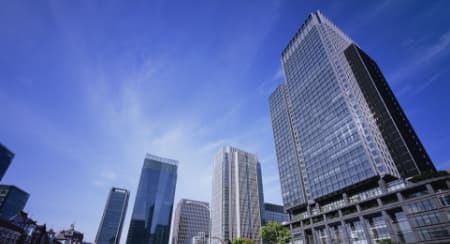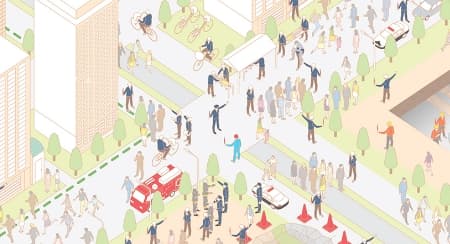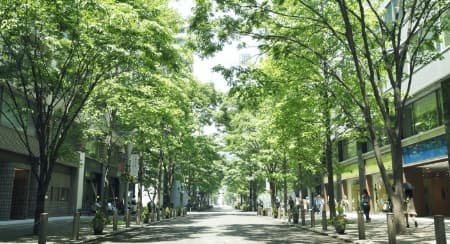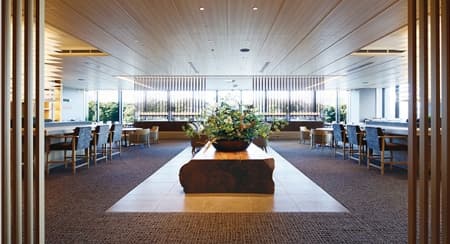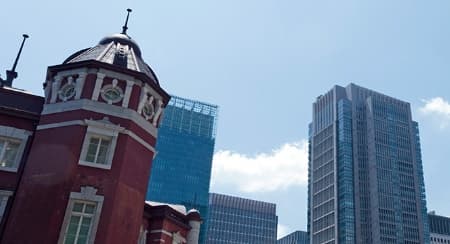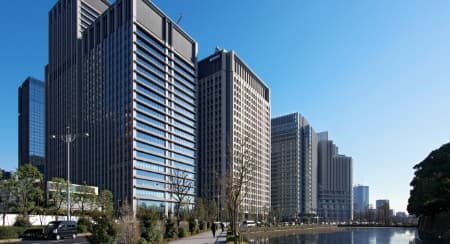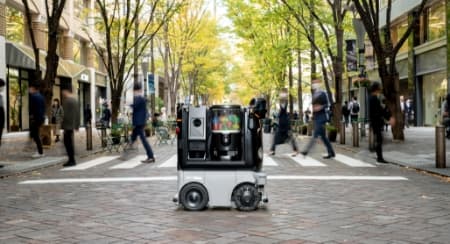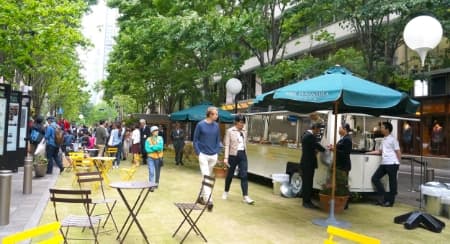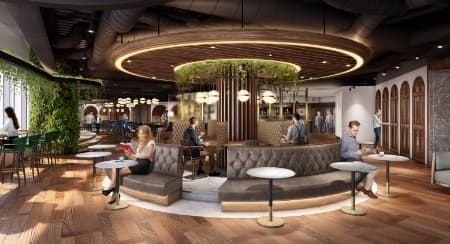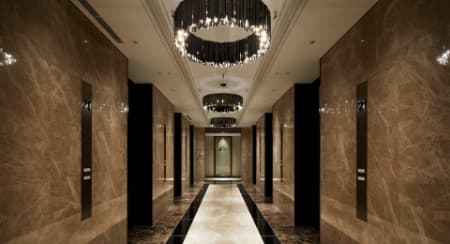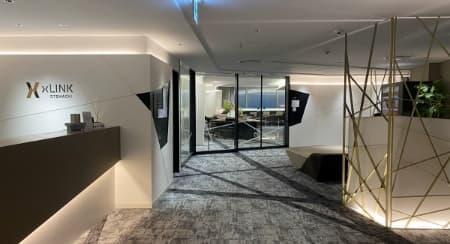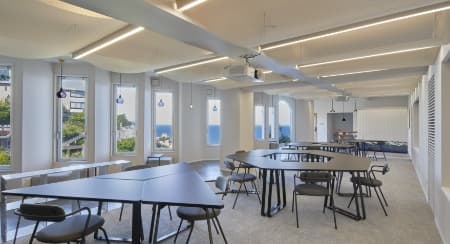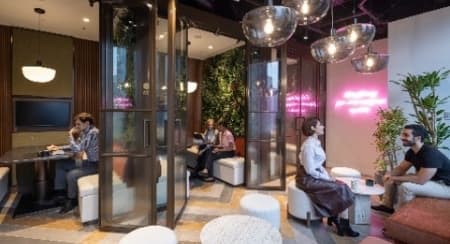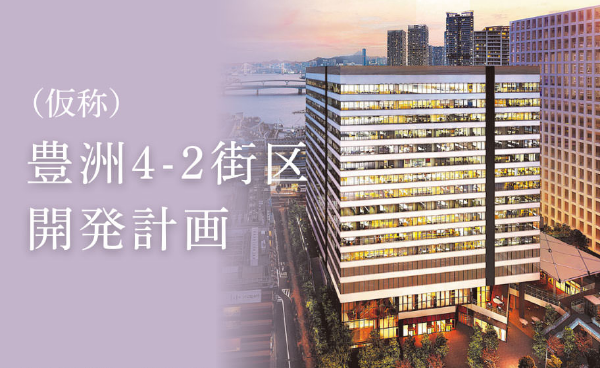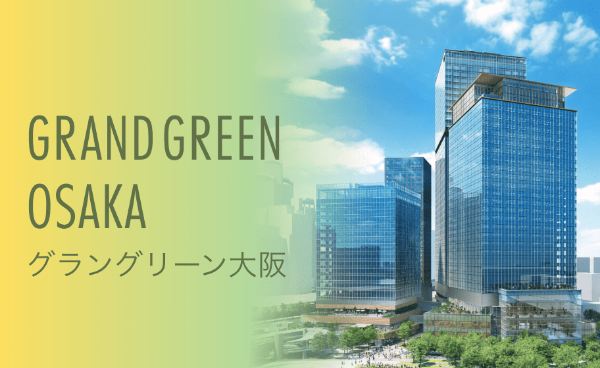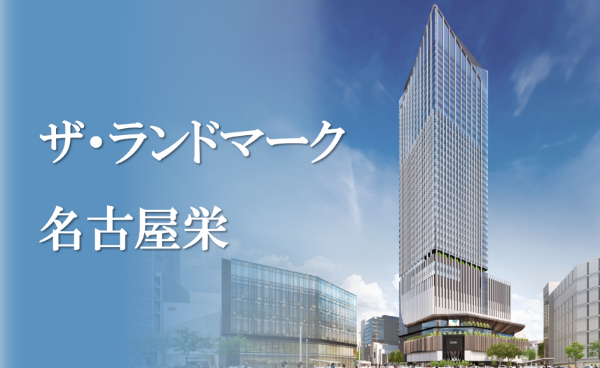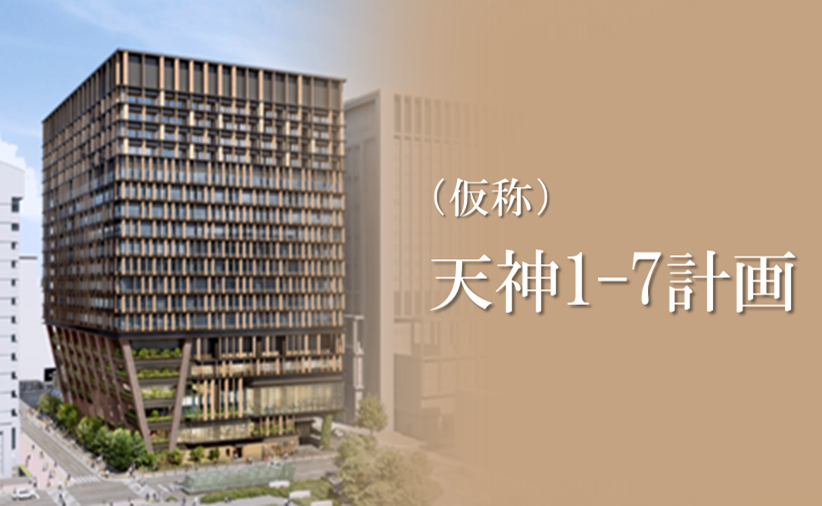2024-09-23
[Tenant Company Interview (Gran Green Osaka)] Kubota Corporation

Kubota Corporation, headquartered in the commercial area of Namba, Osaka, announced this spring that the company will relocate its headquarters to Gran Green Osaka. We spoke with Kubota Vice President Masato Yoshikawa and members of the project team for the new office about their aims for making Umeda, Osaka, their new base, the concept for the new office to promote open innovation, and their outlook for the new location.
PROFILE
Kubota Corporation
Founded: 1890
Number of employees: 14,638 (non-consolidated) / 52,608 (consolidated) (as of December 31, 2023)
New head office location: 5-54 Ofukacho, Kita-ku, Osaka City, Osaka Prefecture Gran Green Osaka Park Tower 15th to 19th floors
Business description: We provide solutions through a wide range of products, technologies and services in the areas of food, water and the environment, which are essential to life, and are working to resolve social issues on a global Floors.
Founded in Osaka in 1890, Kubota has since produced a variety of products and services that contribute to people and society, such as cast iron water pipes and agricultural machinery. The company is also actively working to solve global Floors related to food, water, and the environment, and in 2021 announced its long-term vision, GMB2030, which aims to become a "platformer that supports life, committed to a prosperous society and the circulation of nature." The company aims to contribute to food, water, and the environment not only in Japan but also around the world, and to further develop as a global company. Vice President Yoshikawa explains Kubota's history, saying, "Kubota's business began with casting."
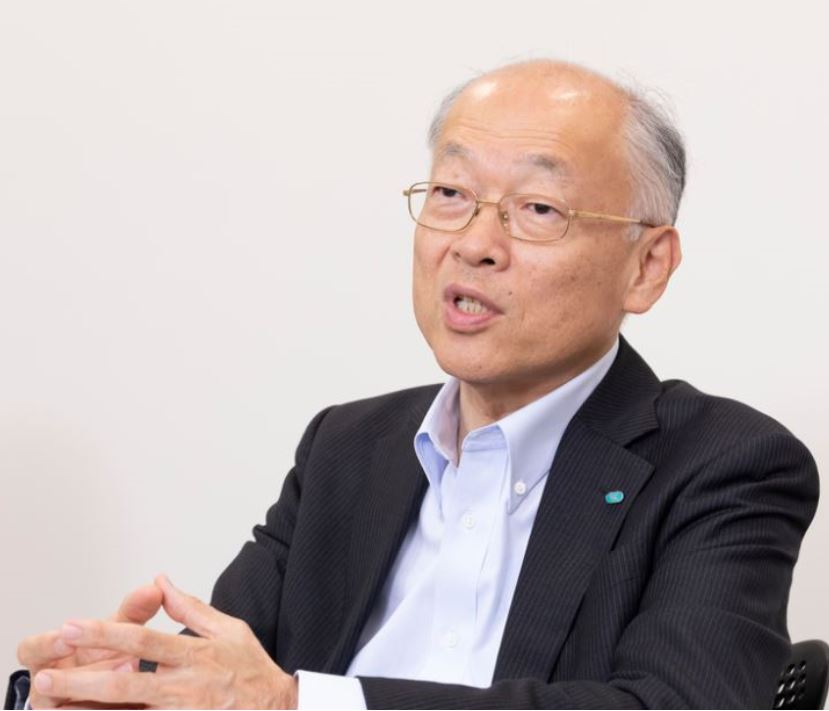
"It is often said in corporate management that change does not occur in homogeneous groups. This is why diversity is necessary, and I personally hope that increasing opportunities to interact with a diverse range of people at Gran Green Osaka will lead to a break down of the homogeneity of our company," said Vice President Yoshikawa.
"Our founder, Gonshiro Kubota, opened a foundry in Osaka in 1890 and began his business by making weights for scales. The manufacture of scales, which was derived from that, continues to this day as one of our businesses, and this year marks our 100th anniversary."
Furthermore, since its founding, the company has been working on projects with the aim of solving social issues in mind. During the Meiji period, when infectious diseases such as cholera were rampant, the country made a concerted effort to develop water supply systems, and in 1897 the company succeeded in manufacturing Japan's first cast iron pipes for water supply.
"We have expanded into a wide range of areas, from manufacturing and selling water-related materials such as cast iron pipes, pumps and valves to processes such as sewage treatment and other water treatment. In response to societal needs, we have expanded into waste treatment, such as incineration plants, and even into the recycling field."
The other trend is industrial engines, one of Kubota's main businesses. The engines, which utilize the casting manufacturing technology that the company has cultivated since its founding, are used in a wide range of applications, including agricultural machinery and construction machinery. "Starting with castings, from cast iron pipes for water supply to engines and agricultural machinery, we have always provided products that meet the needs of society," Yoshikawa continues.
Kubota has grown with the mission of supplying what society truly needs in the areas of food, water, and the environment. What was the reason for choosing Gran Green Osaka as the site for creating new innovation?
"Kubota has offered a variety of products and solutions with the aim of resolving social issues. However, with the changing times, we felt a sense of crisis that our business model of just making things in our own factories and selling them was no longer enough to meet customer needs," said Yoshikawa. With rapid advances in technological innovation such as AI and globalization, we are entering an era of great transformation in which the industrial Structure is undergoing discontinuous change at an unprecedented scale and speed. He will explain the accompanying changes in customer needs with examples.
"For example, the combine harvester developed by Kubota can measure the yield of grains and the protein and moisture content, which affect the rice's taste, over a 10-20m mesh while harvesting and threshing the rice, and this data can be used in farming plans for the following year. To further improve the accuracy of this function, we are collaborating with another company that offers an AI-based service that uses satellite images to analyze growth trends. In this way, we can create solutions together with other companies that have cutting-edge technology to better meet the needs of our customers. To achieve this and promote it, we need to actively communicate with people outside the company and promote co-creation through collaboration, which we believe is the path to growth for our business."

Gran Green Osaka will house a core facility for industry, government, academia and the public called JAM BASE. It will be a base where a diverse range of people from universities, research institutes, start-up companies and other organizations can come together to collaborate and turn new ideas into reality. Mr. Yoshikawa spoke about the aim of relocating the headquarters functions as follows:
"Currently, Kubota is located in Knowledge Capital in Grand Front Osaka and has built cooperative relationships with various startup companies, but Gran Green Osaka will enable closer collaboration with startup companies, universities and research institutes, creating an environment conducive to the creation of innovation. This will enable us to communicate more proactively, which will help drive the growth of our business. This is the main reason for relocating our head office functions."
Furthermore, Kubota, which holds the top share of the domestic agricultural machinery market and boasts high sales figures worldwide, also saw Gran Green Osaka's convenient access to Kansai International Airport as an international company, which Yoshikawa continues.
"Approximately 80% of our company's sales are overseas. Looking at the number of employees in the entire group, the number of employees overseas is also on the rise. We also have a large number of business trips to our overseas bases and customers visiting Japan from overseas. We have high hopes that the new office will also help to promote communication with these people."
For Kubota to make further leaps in this era of changing industrial Structure, it needs to promote co-creation in a place that has cutting-edge technology and the human resources necessary to create new solutions. Gran Green Osaka is a hub for the Kansai transportation network and has a direct connection to Kansai International Airport, creating an innovation platform that brings together information and human resources.
The new office is located on the 15th to 19th floors of the Gran Green Osaka Park Tower. Hironori Furuno, who toured the office, recalled his first impression as follows:
"From the new office, we could see the lush park and the Yodo River, and I honestly thought it was a magnificent view. At the same time, it was a perfect location for our company, which is expanding its business globally with the mission of solving social issues related to food, water, and the environment, and I felt humbled to be working here."
The current head office in Naniwa-ku, Osaka City is made up of several buildings Completion around 1970, but as they have aged, it has become difficult to secure space for communication between group companies and departments. The new office will have Area per floor that is about 5.5 times larger than the current head office. Multiple group companies and departments will be able to work on the same floor, increasing opportunities for interaction across organizational boundaries. Furuno says that the keywords for the new office are "co-creation" and "collaboration."
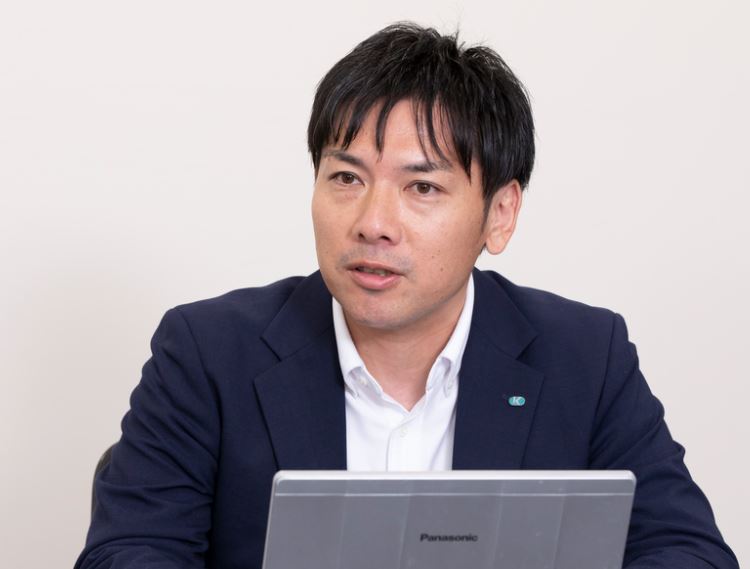
"Since our founding, we have been supported by a great many local people in the Namba area. Even after moving to the Umekita area, we hope to continue building relationships with a wide range of people, including local residents and the community," says Furuno.
"We aim to create an office that everyone wants to come to by implementing various mechanisms that will generate co-creation. We will improve the hard aspects, such as traffic flow and floor layouts, to encourage active communication, as well as the soft aspects. For example, our company has introduced a free address system in some areas, but it cannot be said that communication has been stimulated yet. We would like to improve such cases as well, and also create mechanisms and mechanisms that connect people with each other using technologies such as digital transformation and IT."
Megumi Norimasa is participating in the project to create the new office space. She is in charge of creating a space that will stimulate internal communication.
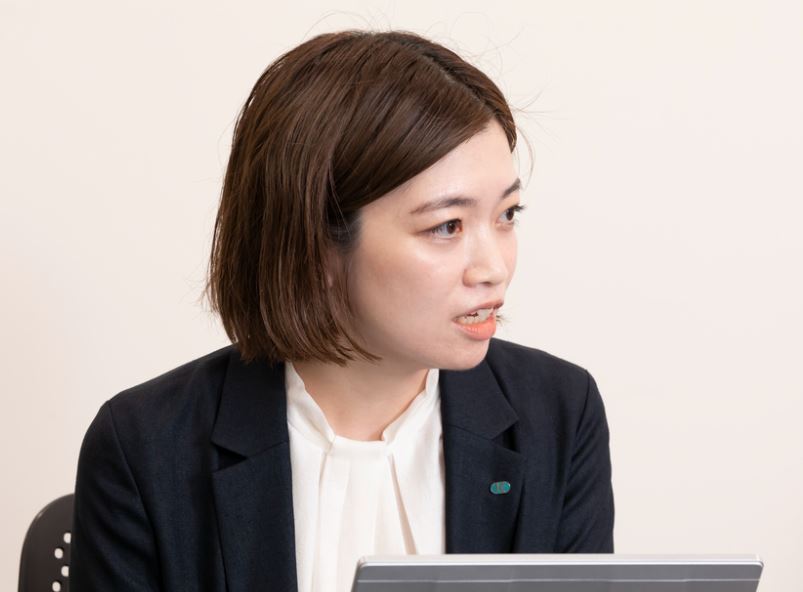
"By coming to Umeda, we at Kubota hope to contribute to the revitalization of the Umekita area and make the local community glad that Kubota came here. We also hope to create an environment in which we ourselves are proud to work at Kubota," says Norimasa enthusiastically.
"In the new office, we aim to create a space that will stimulate communication both inside and outside the company. Although it is still in the planning stage, we would like to create a variety of spaces, including workspaces for people who want to concentrate on their work alone, discussion spaces where staff from both inside and outside the company can freely throw out ideas and discuss them, and spaces where employees can gather and communicate casually. Personally, I am hoping that the introduction of a stepped pitch space will create a new atmosphere. I would like to create a space where discussions and presentations can be held in a relaxed manner at times, and at other times with more energy. By providing a variety of office spaces, we aim to realize ABW (activity-based working), where employees can freely choose the 'place' and 'time' they work depending on the nature of their work and their mood."
Takayama Ayu is working hard to create a company cafeteria that will stimulate communication among employees. The current head office cafeteria has the unique features of Kubota, and he is considering various ideas for the new office as well.
"The current head office cafeteria is located in the basement of the building, and will be renovated once in 2023. It is not just a place to eat, but has been designed with attention to detail, such as a space equipped with monitors so that it can be used for meetings and socializing, and comfortable sofa seats, to create a space that encourages active communication between employees. The employee cafeteria in the new office will also follow the same idea of making it a space that can be used for a variety of purposes. On top of that, just like in the office space, we would like to incorporate the perspective of promoting communication within and between departments into the employee cafeteria as well."
Takayama explains the aim of creating a space that promotes communication in the employee cafeteria as follows:
"At Kubota, we have regular one-on-one meetings between managers and subordinates with the aim of strengthening individual relationships. These meetings can be held in a variety of locations, but we hope to make the new cafeteria a bright, open space that will be chosen as a place for these meetings. Kubota also holds regular in-house events to promote interaction between group companies and departments. In order to be able to continue these unique Kubota initiatives, we have paid particular attention to the layout and fixtures, devised ways to make the cafeteria a starting point for interaction, and created a space where employees can experience our company's values and business, creating a space where employees can reaffirm their pride in the company," he says enthusiastically.

"It reminded me of when I was a job-hunting student. With the relocation of our head office and the new facilities, I think we will see an increase in new applicants, attracted by the location and facilities. I am looking forward to this place becoming a place where diverse talent from both Japan and overseas gathers and new ideas are generated," said Takayama, who is in his second year with the company.
From Namba, the place where the company was founded, to Umekita. Taking advantage of the characteristics of the city of Gran Green Osaka, where greenery and people mingle, a new chapter is about to begin for Kubota as it promotes open innovation. Regarding future prospects, Executive Vice President Yoshikawa continued:
"There's no point in just doing the same things we did when we were at the Namba headquarters. In addition to revitalizing communication both inside and outside the company, we aim to create a place for lively interaction with stakeholders, including the local community and business partners. We hope that this increased communication and interaction will lead to growth for Kubota's business itself."
Photo: Koichi Higashitani Text: Akiko Wakimoto
Gran Green Osaka Project Site Article <FEATURES>Reprinted from
